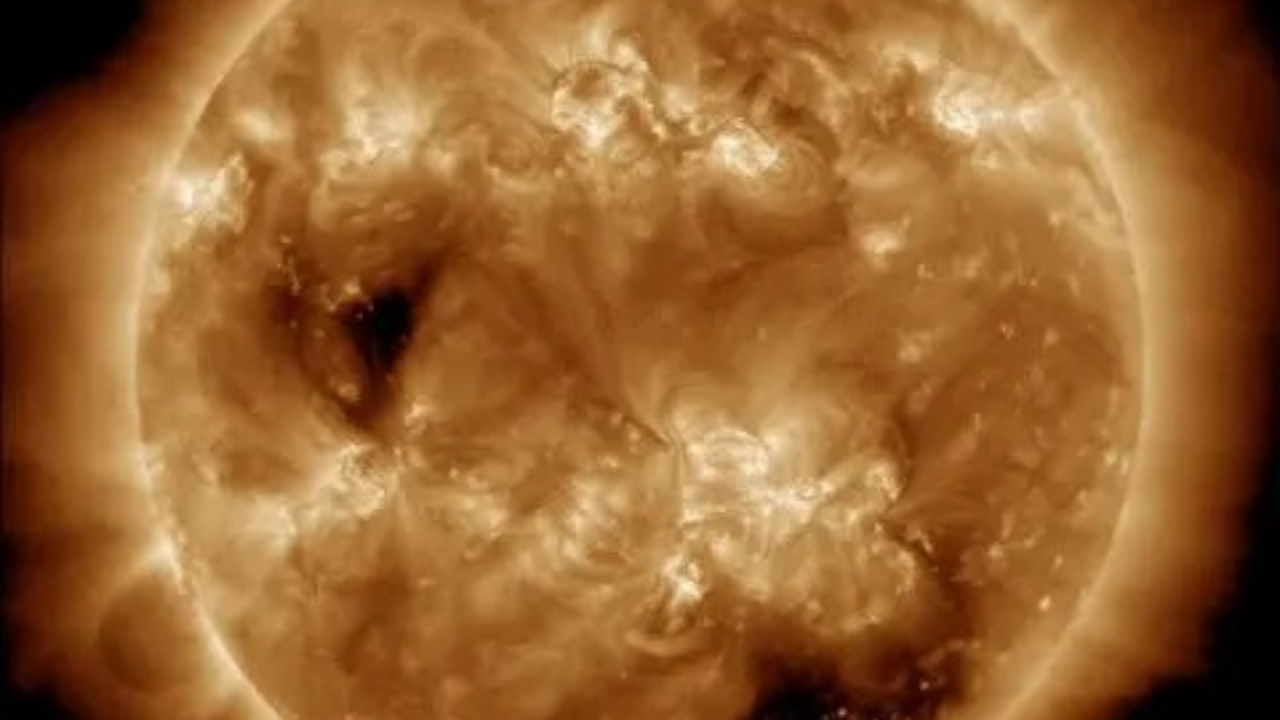Nasa scientists find massive hole on Sun, 20 times larger than Earth - Times of India
 [ad_1]
[ad_1]

Nasa scientists have spotted a massive black region on the Sun, which is 20 times larger than Earth. The appearance of the “coronal hole” has prompted US federal agency National Oceanic and Atmospheric Administration (NOAA) to sound out an alert for geomagnetic storms as the gaping hole is unleashing 1.8 million mile-per-hour solar winds towards Earth, which will impact the planet on Friday.
Scientists are closely monitoring the situation to see if the winds will impact the Earth's magnetic field, satellites and technology. This was the second hole to appear in one week. Both holes were captured by Nasa’s Solar Dynamics Observatory, which studies the Sun. The latest hole was discovered on March 23 near the Sun’s South Pole. The “hole” isn't really a hole, but a large region much cooler than the rest of the Sun, causing it to appear black.
“Coronal holes are magnetically open areas that are one source of high-speed solar wind. They appear dark when viewed in many wavelengths of extreme ultraviolet light. At times, the solar wind can generate aurora at higher latitudes on Earth,” explains Nasa.
Geomagnetic storms are classified using a five-level NOAA space weather scale. The larger and more expansive coronal holes can often be a source for high solar wind speeds that can batter Earth for several days. Because of their potential for escalated geomagnetic activity and possible storming (G1 or higher), forecasters analyse coronal holes closely.
Coronal holes are most prevalent and stable at the solar north and south poles; but these polar holes can grow and expand to lower solar latitudes, says Nasa. It is also possible for coronal holes to develop in isolation from the polar holes or for an extension of a polar hole to split off and become an isolated structure. Persistent coronal holes are long-lasting sources for high-speed solar wind streams.
[ad_2]
Source link
https://worldnews2023.com/top-stories/nasa-scientists-find-massive-hole-on-sun-20-times-larger-than-earth-times-of-india/?feed_id=66015&_unique_id=64d0838e081af
Scientists are closely monitoring the situation to see if the winds will impact the Earth's magnetic field, satellites and technology. This was the second hole to appear in one week. Both holes were captured by Nasa’s Solar Dynamics Observatory, which studies the Sun. The latest hole was discovered on March 23 near the Sun’s South Pole. The “hole” isn't really a hole, but a large region much cooler than the rest of the Sun, causing it to appear black.
“Coronal holes are magnetically open areas that are one source of high-speed solar wind. They appear dark when viewed in many wavelengths of extreme ultraviolet light. At times, the solar wind can generate aurora at higher latitudes on Earth,” explains Nasa.
Geomagnetic storms are classified using a five-level NOAA space weather scale. The larger and more expansive coronal holes can often be a source for high solar wind speeds that can batter Earth for several days. Because of their potential for escalated geomagnetic activity and possible storming (G1 or higher), forecasters analyse coronal holes closely.
Coronal holes are most prevalent and stable at the solar north and south poles; but these polar holes can grow and expand to lower solar latitudes, says Nasa. It is also possible for coronal holes to develop in isolation from the polar holes or for an extension of a polar hole to split off and become an isolated structure. Persistent coronal holes are long-lasting sources for high-speed solar wind streams.
Comments
Post a Comment